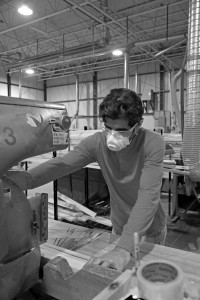Palliser Furniture is a family owned furniture manufacturing company in Winnipeg, in the Western Canadian province of Manitoba. Once staffed by the Mennonite community with roots in Russia and Eastern Europe, over time, Palliser’s workforce expanded to workers from 70 nations who speak 40 languages.
With a long history in immigrant employment, Palliser has key lessons for employers seeking to become more immigrant and diversity confident.
Build on immigrants’ attitude and aptitude
In retired CEO Art DeFehr’s experience, immigrants are motivated people. He should know, his own parents immigrated to Manitoba where his father first began building furniture in his basement.
DeFehr, who lead the company from 1984 to 2015, noticed a pattern among immigrant employees that became Palliser’s strategic advantage: attitude and aptitude.
“In the factory, we oriented our business toward immigrants. We developed special programs for immigrants and a lot of them were refugees. We had programs to deal with the person getting off the boat with no industrial experience,” DeFehr said.
At Palliser, innovation in human resources practice came from the needs the company observed among new recruits. For example, limited English language. As an increasing number of South and Southeast Asians made Winnipeg their home in the last few decades, Punjabi and Tagalog communities grew quickly. So Palliser began to offer English language classes. Later, the company added literacy, math and numeracy, computer, and leadership programs. Training on the job became standard practice.
The flexibility and training resources it developed allowed the company to hire new immigrants who may have lacked particular skills, but showed the aptitude to learn, and the attitude managers were looking for.
These qualities became increasingly important. So much so that today, Palliser actively hires those who may be inexperienced but highly motivated.
A different way to hire
Palliser foregoes a conventional interview process. Prospective employees are screened in an initial information session, and tour one of the plants to ensure they understand the jobs available. They are then invited to a two-day assessment process to test whether their skills match the job requirements. Where needed and possible, trainers speak the candidate’s preferred language. Those hired after the two-day assessment join an employment pool where they can get additional training.
DeFehr found the approach was essential with the size of the company’s annual recruitment, in the range of hundreds of new hires a year, with people from many different backgrounds and skills.
According to Andrea Aiello, Palliser’s Corporate Human Resources Manager, while the company lacks the large human resources department and employee base it once had, the earlier experience became ingrained in their hiring. “We don’t think in terms of return on investment, but in terms of the people we look for. We hire now more in the range of three to five employees per week, and our approach allows us to spend more time with each individual. We still do some skill testing, but more than looking for the exact experience, we’re still looking for aptitude. Our observations give us a good indicator of success in the company.”
Managing diversity
DeFehr understood that if Palliser was going to focus more on aptitude than previous experience, the company needed to enhance not only its training, but also its communications. They learned that a more formal approach to worker feedback, built on clearly understood expectations of output, quality, and efficiency, worked best.
DeFehr also realized that a diverse workforce on the factory floor meant diverse communication challenges. He hired human resources staff who had experience with English as a Second Language (ESL) employees. The ESL-trained staff reviewed documentation and customized it to be friendly for non-English-speaking workers, simplifying language, or using videos and pictures. Using simple and plain language made the information accessible for everyone.
A private sector role in immigration
“We design buildings, bridges, roads, communities and sometimes cities,” Art DeFehr said. “Can we and should we design our population?”
For DeFehr, an employer’s role in hiring immigrants extends from the tactics of inclusive hiring and onboarding, to discussions about the private sector’s role in immigration policy.
The immigrant population arriving in Manitoba has changed over time. But Palliser’s approach has not. It remained rooted in investing in its workforce and community, even in turbulent economic and industry times.
The local development perspective is an important one in immigration. DeFehr realized that, in order to reflect local priorities, employers can and need to be drivers of immigration policy. DeFehr himself was a key actor in the development of the successful Manitoba Provincial Nominee Program (PNP), which gives Canada’s provinces greater say in the traditionally federal domain of immigrant selection. Manitoba was the first province to adopt the PNP and has tripled its share of immigrants to Canada over the course of a decade as a result. The majority of Manitoba’s newcomers arrive as provincial nominees.
DeFehr knows that migration happens with or without the leadership of business. That’s why business should aspire to have a say. DeFehr argued, “business does not like uncertainty so it is in our interest to bring certainty and logic to a phenomenon that can be life-giving and energizing to both the host country and the individual migrant – or it can be disruptive for society and a disaster for the individual. We can do more than provide jobs and move money – we can contribute to the policy questions in the critical area of migration.”
Writing about how the Manitoba model emerged, DeFehr recommended that employers work with government to create a plan focused on people who would be likely to succeed in their local economy and community.
He argued that cities need to focus on people who don’t just immigrate, but rather, those who can integrate. Government can and should design programs to better meet local needs. Policy should come out of a deeper understanding of each community, designed and driven with strong private sector participation.
Building effective population policy can be like running a successful business. “Design captures the attention of our consumers. Innovation creates distinctiveness that lead to value. Excellence in service closes the loop to a successful sale,” DeFehr wrote. “But people make it happen. People who are competent, committed and who care.”
Tips for employers
- Revisit hiring practices to emphasize qualities like motivation and aptitude for learning, and focus on upskilling afterwards.
- Consider employees as the company’s greatest resource. Their word of mouth will bring like-minded people to your company. That means how you hire, onboard, and manage talent has a direct impact on who you attract to hire next.
- Your greatest resource is worth investing in. You may find the right person who lacks the complete skill set you need. Create the structure to bring them in, train them, and build a success pipeline for them. In addition to other benefits, this kind of access to opportunity within a company nurtures employee loyalty.
- Seek employee feedback to design training that fits their needs and the needs of the company.
- Consider employee success as community success. Enhancing growth opportunities will create advantages that extend beyond your company, into your community.
Resources
Hire Immigrants Roadmap for Getting Started
Art DeFehr’s writing on immigration
The Manitoba Provincial Nominee Program for Business
Palliser Furniture



